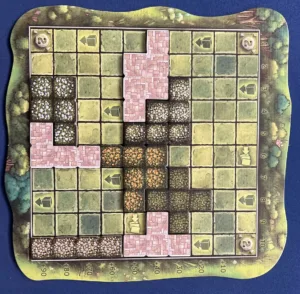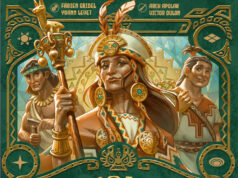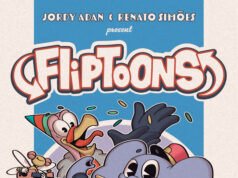 Glenn Drover and Forbidden Games go together like peanut and jelly: Racoon Tycoon, Railroad Rivals, Lizard Wizard, and Mosaic: A Story of Civilization have all had varying amounts of success.
Glenn Drover and Forbidden Games go together like peanut and jelly: Racoon Tycoon, Railroad Rivals, Lizard Wizard, and Mosaic: A Story of Civilization have all had varying amounts of success.
Now this dynamic duo have teamed up again to bring us Faeries & Magical Creatures. Can this reach the heights of their strongest pairings, or will this merely be a footnote in their history together?
Gameplay Overview:
Faeries & Magical Creatures is an action selection game where each turn, players will be choosing one of five simple actions to take. Unlike more traditional action selection games, Faeries & Magical Creatures borrows from games like Race for the Galaxy and Earth where each player gets to act on each other player’s turn as well. This means that if Player 1 chooses Helping Hand, each other player gets to do Helping Hand as well.

To balance this mechanism out, the active player always gets to play a card from their hand. These cards are the real meat and potatoes of the game. See, one of the actions that players can take is Befriend a Faerie, which allows them to draft a new card from the public splay. These cards modify certain actions, introduce thievery, give extra points at the end of the game for reaching certain conditions, and so on.
Faeries & Magical Creatures also has a spatial puzzle and area control element. One action players can take is to Build a Garden. These garden pieces are tetrominoes that players will be placing on their personal player board to cover up bonus squares for extra actions. These tiles can be played path-side up, or garden-side up. At the end of the game, garden-side up tiles that are touching path-side up tiles that are touching the outside border of the player board score extra points! As for the area control element, each player has Kinship cubes they will be placing down with five different factions. At the end of the game, the player with the most in a chosen faction will score 1 point for each cube there (including those of other players!)
Befriend the right fae creatures, build the best garden, and establish hearty kinships to win Faeries and Magical Creatures.

Game Experience:
I’ve thought long and hard about my time with this game. Let me be clear upfront that Glenn Drover and Forbidden Games have really produced some fantastic titles, and this one is no different. Being able to take 3,892,764 different systems, interweave them together, and distill them down to the point of the games being gateway level truly is nothing short of something special.

I also want to point out the amazing work that Annie Stegg-Gerard has done with the art in this game and all other Drover/Forbidden Games collabs. The art is clean, beautiful, recognizable, and readable, traits that most artists fail to grasp in this space. Also, it warms my heart to see the same artist being used each time because it adds recognizability to those who aren’t in the weeds enough in the hobby to notice designer and publisher names. Being able to add comfort to newer consumers on the lighter end of the hobby is something that most publishers don’t consider, and I’m super pleased to see that here.
This game is light. As a crusty old gamer myself, I could tell exactly what was happening just from the action names and descriptions. There were some rules here or there that I still had to get from the rulebook, but this game just set itself up on the table. What I find most impressive about this game’s ease of playability is the fact that the game has three main mechanisms at play here: deck building, area control, and tile placement. Yet, even with all three of these elements, each one is so simple with little chrome that each part is simple enough on its own to teach in a minute.

The problem with this game’s weight is that, frankly, it makes the game feel like it has no home. This game felt too light and unengaging for my partner and me. There were some neat wrinkles with the timing and impact of certain cards, and we appreciated how each “suit” of cards could be added in higher quantities to give a more defined “shape” to your deck, but that was about it. The tile placement was straightforward, the card drafting was usually a no-brainer, and where to place Kinship tokens was often quite obvious. This is not to say that this game is without strategy or thought, because that’s entirely not true; however, for gamers used to heavier games, these decisions felt second nature and not brain burny.
On the opposite end of the spectrum, I felt the game was simple enough to try to get my mother-in-law to try it, and that was still too much. She has handled simple card games and games that mimic the structure of older games in the past (like how Magical Athlete is essentially just a roll-and-move game with some player powers), but that’s about what she can handle. Having to teach the basics of deckbuilding, placing tiles, action selection, and area control was far, far too much, even if each one is simple on its own.
Final Thoughts:
Faeries & Magical Creatures is a delightfully breezy game. Its tight design makes it engaging, and its simplicity makes it a great game for those interested in joining the hobby. If you’ve played a ton of other board games I don’t think this will be engaging enough for you, and I don’t think this is light enough to be a family game. If you fit the audience here, you will enjoy its many layers and flexibility that the deck building adds to the action selection.
Final Score: 4 Stars – Glenn Drover and Forbidden Games’ lightest and tightest affair yet.
 Hits:
Hits:
• Beautiful art and fantastic production
• Thinky, simple deckbuilding
• Simple teach, fantastic depth
Misses:
• Narrow audience in a crowded market
• Card powers too variable
• Player scoreboard can be confusing





















